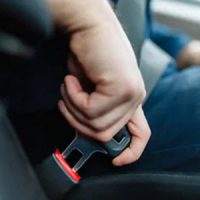Seat Belt Injuries

The first lap seat belts were introduced in the late 1890’s, but didn’t become standard in most passenger vehicles until the 1960’s. In 1973, however, the lap belt was upgraded to a three point harness, which led to an almost 50 percent decrease in fatal injuries. Unfortunately, besides preventing serious injuries, seatbelts can actually cause them in certain cases. Seat belt injuries, or seatbelt syndrome occurs when the force of a crash causes everything from bruising and abrasions to intra-abdominal injuries and vertebral fractures.
Seatbelt Design
Seatbelts are specifically designed to transmit the energy of a vehicle collision to the clavicle, chest wall, abdomen, and superior pelvis. This keeps occupants in their seats, preventing head injury and ejection from vehicles, and in doing so, avoiding thousands of fatal injuries every year. However, because the three point harnesses rest on the shoulder, abdomen, and chest, it is possible for the force of impact to place significant force onto these body parts. This can cause damage to the underlying structures to the neck, chest, and abdomen.
Seat Belt Injuries
When the seatbelt acts as a fulcrum, with a point of contact in the same fixed location (the shoulder, chest, and abdomen), the areas above and below often continue forward. This can cause significant injuries, including external injuries, like skin abrasions and bruising, as well as internal injuries, such as:
- Liver and spleen lacerations;
- Injuries to the pancreas or kidneys; and
- Tearing of the bowel and intestines.
Fractures are also common seat belt injuries, especially in the lumbar spine. Victims could also sustain thoracic injuries, such as sternal fractures, broken ribs, and pulmonary contusions. When the seatbelt strikes the neck, a person could also sustain a cervical spine or clavicle fractures.
Signs of Seat Belt Injuries
Seatbelt injuries aren’t always immediately noticeable to accident victims, but could crop up hours or even days down the road. This is why it’s so important for accident victims to keep an eye out for certain symptoms, which could be indicative of a seatbelt injury. These symptoms include:
- Bruising;
- Blood in the stool or urine, which could be a sign of internal bleeding;
- Leg weakness resulting from damage to the lower back;
- Difficulty breathing, which could be evidence of injury to the lungs or heart;
- Abdominal pain, which could signal injury to the kidneys or another organ; and
- Neck stiffness or pain, which could be evidence of a whiplash injury or spinal fracture.
If you suffered any of these symptoms after a car accident, you could have sustained a serious seatbelt injury. Seek medical attention right away and consider speaking with an attorney about your legal options moving forward.
Schedule a Free Case Review Today
When you are hurt in a car accident and need the help of an experienced lawyer who can provide you with advice and guidance, call on the dedicated Florida car accident legal team at Boone & Davis. You can set up a consultation with us by calling 954-566-9919 or by completing one of our online contact forms.
Sources:
nhtsa.gov/risky-driving/seat-belts
ncbi.nlm.nih.gov/books/NBK470262/
